When using JDBC to retrieve query results I use ResultSet like:
ResultSet result_set = statement.executeQuery(query);
In documentation it says: "A ResultSet object maintains a cursor pointing to its current row of data." meaning that if I do result_set.close() before I parse the query results I loose them. If I parse data in ResultSet right away I’am maintaining connection to the database during parsing process. I want to minimize time, I want to parse query result without being connected to the DB.
Is there a way to store query data in such way that I can close connection to the database before I parse the results?
for example something like this:
Connection connection = DriverManager.getConnection(url, username, password);
Statement statement = connection.createStatement();
ResultSet result_set = statement.executeQuery(query);
// store data retrieved from query
result_set.close();
statement.close();
connection.close();
// do something with stored data




2
Answers
RowSetThe
javax.sql.rowsetpackage extendsResultSet, adding various features.In particular,
CachedRowSetcopies the rows’ data into memory. To quote the documentation:The problem is finding a capable concrete implementation of the interface. Oracle provides an open-source reference implementation from the days of Sun. But, as I recall (and I may be wrong), that implementation had some limitations or flaws that went unaddressed. Be sure to test thoroughly.
To fill the blanks in your snippet with a minimalistic approach:
This assumes you know the ordering in the returned data and the types to do the ‘parsing’ / etc later on.
Thinking about the computationtime needed for the ‘parsing’ and the memoryfootprint and so on is a good way to become familiar with the behavior of the framework. I recommend trying out diffent sizes of resultsets (in number and rows) and the complexity of the parsing/ transformation. Maybe a look at a jpa-implementation helps to understand the possible solutions.
In this post more details regarding result-extraction can be found: How to fetch entire row as array of objects with JDBC